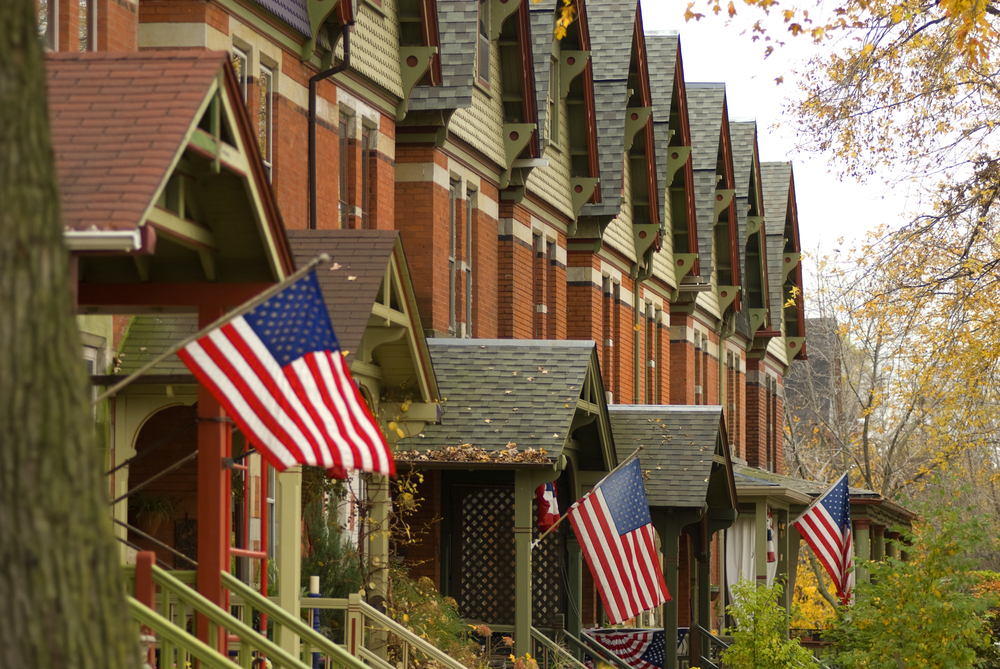Sociologist Robert Nisbet declared our era to be “singularly weak” in social inventiveness. In a new book on local solutions to America’s social ills, author Seth Kaplan agrees—with some exceptions. “Our modern era is not the first one in which the U.S. has weathered rapid social change,” Kaplan writes, “but it’s the first time we have endured it without the kind of social innovation needed to mitigate the ill effects of that pelting change.”
In Fragile Neighborhoods: Repairing American Society, One Zip Code at a Time, Kaplan calls for a quiet revolution in American life—from the way government and nonprofits provide services to the way its people conceive of their dreams and aspirations. His book features a handful of individuals and organizations in the vanguard of that revolutionary action and shares practical steps for how you can join.
Kaplan, a professorial lecturer at Johns Hopkins University and a state-building consultant, has spent his professional life working with “fragile states,” countries teetering on the edge of collapse due to economic or political catastrophe. When people learn this, Kaplan relates, they often ask him whether the United States is itself fragile.
His answer is that the American state and economy are strong—as their resilience under extreme stresses in recent years backhandedly affirms—but that American society is weak, weaker even than some of the societies deemed “fragile” in poorer and less powerful regions of the world. America’s peculiar fragility can be found not in our political or economic institutions but in the very places where we live, work, play, and die: our neighborhoods.
America’s social poverty contrasts poignantly with our country’s material wealth and is at the root of any number of social pathologies that are giving “American exceptionalism” a new meaning in comparison with the world’s other rich nations. Among others, Kaplan flags our loneliness epidemic (officially declared by the U.S. surgeon general in May), worsening mental health crisis, family disintegration, and so-called deaths of despair related to alcoholism, drug abuse, and suicide as “social problems that shock the rest of the world, and ought to shock us.”
“Our prosperity as a nation doesn’t seem to have improved our well-being,” Kaplan writes in the introduction. “If anything, it has left millions of people and families feeling more alienated and discontented than ever.”
Kaplan argues that repairing American society requires a renewed commitment to place—from both institutions and individuals—and even a reformulation of the American Dream. His vision is attractive in that what it demands is actually quite modest, but its effects could save your neighborhood.
Fragile Neighborhoods is distinctive in the amount of space Kaplan devotes to solutions. He spends most of the book profiling five organizations he sees as doing the right kind of “social repair” in the right kind of way, presenting them as models for the reader to follow in her own community. Besides being a compelling book, Fragile Neighborhoods is a practical one.
The problem, as Kaplan sees it, is that American institutions tend to prioritize individual actualization and success at the expense of community. A critical mass of cultural, political, and economic forces has driven us into patterns of life that, in the words of writer Mary Eberstadt, “are profoundly unnatural for the ineradicably social creatures that we are.”
“[Many] are suffering as a result,” Eberstadt writes, quoted by Kaplan, “at times without even knowing that name of what ails them.”
Nowhere is this partiality for individualism over community more apparent than in our neighborhoods, perhaps represented most clearly in the cookie-cutter housing development without sidewalks. Technically, we live in proximity to each other, but our lives don’t intersect. Kaplan summarizes this movement in American life as a transition from a “townshipped” society to a “networked” one, where we tend to communicate with each other impersonally and often transactionally.
“The very concept of belonging to a place, a neighborhood, a locality—somewhere we belong and call home has all but disappeared,” wrote the late author and rabbi Lord Jonathan Sacks. The net result is profound alienation, which Kaplan argues is the source of our social fragility and affects the poor, middle class, and rich alike, albeit in different ways.
Kaplan suggests that “place-based” disadvantages—rather than race, income, or other social factors—is becoming a better lens for understanding why some Americans thrive and others do not. Racial prejudice and its attendant evils linger like ghosts exactly in the physical places that were systematically disinvested in decades ago.
For example, one of the most jarring place-based statistics Kaplan shares is life expectancy. Across the U.S., life expectancy varies by more than 40 years depending on the zip code an American is born into. Babies born in the Washington, D.C.-area neighborhoods of Friendship Heights and Friendship Village can expect to see their 96th birthday. Just 10 miles across town in Anacostia’s Barry Farm, however, the average life expectancy is 63.2 years.
“Zip code may not be destiny, but it operates like gravity,” Kaplan writes. “It exerts tremendous pull on its children, for good or ill. Can you break the pull? Of course! But most won’t.”
Attempts to lift hurting communities typically take the form of providing services to individuals—meeting specific needs such as better housing, youth mentoring, or access to better healthcare—while the conditions creating those needs are left almost untouched.
Even when successful, these “individual” approaches to social problems—whether implemented by government or nonprofits—tend to overlook the very local circumstances and context for a community’s problems.
“These efforts may benefit some,” Kaplan writes, “but they don’t do much to strengthen the institutions and structures that are essential to improving neighborhoods and the lives of residents there on a sustainable basis.”
The practical effect of these kinds of interventions is often to help individuals get out of a neighborhood. Individually, this can be a good thing; for a community, as its best and brightest leave, it can spell disaster.
Since 1970, the number of urban neighborhoods with concentrated poverty has tripled, affecting more than 800 neighborhoods, and the number of impoverished people living in them has doubled. This economic sorting of America exacerbates the problems of material poverty by creating “an intergenerational, multiplying effect” of environmental stressors, traumatic experiences, and family chaos.
Even if individuals are able to escape their dysfunctional neighborhoods, however, they are likely to encounter a new blast of social headwinds in America’s suburbs. Kaplan actually spends more time in Fragile Neighborhoods exploring the social problems of the relatively well off than he does those of the poor. In doing so, Kaplan suggests that American “fragility” is pervasive and growing in the middle class—in other words, at the very core of our national life.
“If we don’t know our neighbors, aren’t active in local community life, pay for others to raise our children and service our elders, and try to buy our way into a good life, we pay a large price,” Kaplan writes. “We produce, unintentionally, as it might be, a weak family, a careless community, and a nation that tries hopelessly to revive itself from the top down.”
So, what should we do?
“We need to stop thinking about our society as a set of individuals,” Kaplan says, “and start thinking harder and more creatively about how we can strengthen the ties that connect us and bring us together—both within and across neighborhoods.”
In contrast to “top down” or “vertical” approaches, Kaplan prescribes “place-based” and “sideways” solutions to American social fragility. When national organizations get involved in neighborhood revitalization, it should be through local chapters intimately familiar with the people and problems faced by the community.
“Place-based approaches reorient us toward the specific social dynamics present in a particular neighborhood,” Kaplan writes, “while shining a light on the particular issues, institutions, and structural factors that matter most to the success of any neighborhood.”
As mentioned, Kaplan spends most of Fragile Neighborhoods exploring solutions to neighborhood fragility. Starting from a framework of key components of community success—including family structure, social capital, access to opportunity, quality schools, racial and income diversity, vital local economy, public safety, and “the built landscape”—he introduces us to five organizations applying a “sideways approach” to community problems.
Partners for Rural Impact, for instance, works in Appalachia to “reweave the fabric of community by connecting young people to their histories, culture and place” and to “engage youth academically and socially, to connect the community to the youth and the youth to the community.”
Life Remodeled in Detroit, meanwhile, has promoted neighborhood revitalization through mass volunteer events, improving school facilities, and developing “community opportunity hubs.” Since the establishment of the first of these hubs, the Durfee Innovation Society in Detroit’s Dexter-Linwood neighborhood, crime in the area has dropped; many more students are accessing after-school tutoring, skills development, and leadership programs; and property values are rising.
Another featured organization, Communio, works through Christian churches to strengthen marriages, leveraging sophisticated consumer data to market their services directly to couples in danger of divorce. Its model is essentially to build up networks of mutual support among married couples in a designated region, leaving enough flexibility “to tailor its approach to the specific needs of the particular people of each place.”
Each profile is affecting and inspiring, not only for the specific work these organizations are doing, but also for the more abstract reason that they confirm that the American social entrepreneur is alive and well.
In addition to calling for a renaissance of institution building, Kaplan exhorts his reader to rethink the American Dream. Today the default aspirations of the young American man or woman tend toward individual success, material gain, and social mobility, Kaplan writes. Encouraged in these goals by many of our institutions, these desires represent a degradation of the Dream, which was once about “developing a social order in which every person’s potential could be fulfilled.”
Instead Kaplan encourages us to invest ourselves in more life-giving goals: our communities, our families, and, of course, our place. “Can we restore the original vision?” Kaplan asks. “I believe that we can.”
Reading Fragile Neighborhoods is a good place to start.

